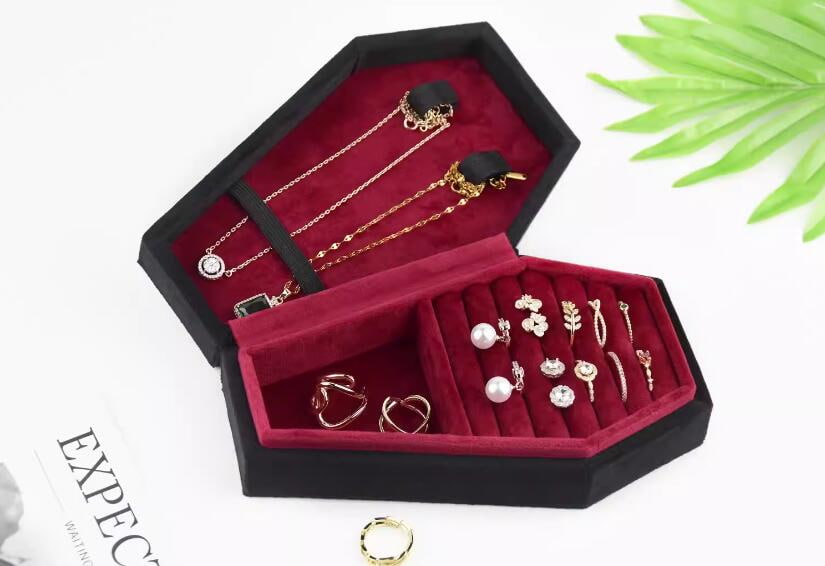You can share
- Share to Facebook
- Share to Google+
- Subscribe to our
- Share to Linkedin
- Share to Twitter

Jewelry boxes are the amplifier of brand premium, and for consumers, they are the first protective barrier for jewelry collection. This article will deeply analyze the essential differences between high-end jewelry boxes and ordinary products, provide industry professionals with a decision-making basis for upgrading products, and help consumers establish scientific purchasing standards.
High-end jewelry boxes generally use aviation-grade aluminum alloy frames, and their 0.8mm precision stamping molding technology can withstand a vertical pressure of 200kg/m². Compared with the ABS engineering plastics commonly used in ordinary jewelry boxes (compressive strength of about 50kg/m²), the protection performance under extreme transportation conditions is improved by 300%. The snake-shaped jewelry box of Italian jewelry brand BVLGARI uses a magnesium-aluminum alloy frame and successfully passed the 3-meter drop test.
The lining of top-level jewelry boxes uses a composite structure of medical-grade silicone and nano-ceramic coating to create a zero-static environment. Experimental data show that this combination can reduce the oxidation rate of silver jewelry by 87%, while the oxidation rate of ordinary flocking lining due to static electricity accumulation is 3.2 times that of the former. Tiffany's iconic blue box lining uses patented anti-oxidation fabric, which has been verified by the laboratory to keep silver jewelry free of oxidation for 6 months in a 40℃/80% humidity environment.
High-end products use CNC five-axis linkage processing, and the hinge accuracy is controlled at ±0.02mm, achieving 100,000 opening and closing tests without looseness. The Swiss watchmaking-grade assembly process ensures that the airtightness of the box lid meets the IP67 standard when it is closed, while the 0.5mm gap common in ordinary jewelry boxes will cause about 3.2mg of dust to penetrate each year.
Elaphe, a top French jewelry box brand, implements a craftsman numbering system. The 60 manual processes for each box body take 120 hours. Its iconic lacquer art process requires 21 layers of lacquer to be applied alternately, and the drying process alone takes 45 days. Jewelry boxes made with this kind of craftsmanship have an annual appreciation rate of 32% in the secondary market, becoming a new category of collectibles.

The temperature and humidity management module built into high-end jewelry boxes can maintain a golden humidity band of 40%-45%RH, and the temperature difference fluctuation is controlled within ±1℃. The smart jewelry box launched by the German brand Rimowa is equipped with a VOC sensor. When the concentration of organic volatiles in the box exceeds 5ppm, the purification system is automatically activated, which is 18 times more efficient than the passive protection of ordinary moisture-proof agents.
The unlocking error rate of jewelry boxes using biometric locks is reduced to 0.0001%, far exceeding the 0.3% error rate of ordinary password locks. Cartier's latest anti-theft system combines GPS positioning and pressure-sensitive alarms, and can send real-time coordinates to 5 bound contacts via satellite in the event of unauthorized movement.
The opening and closing angle of high-end jewelry boxes strictly follows the 85° golden rule. At this angle, the user's line of sight forms a perfect 115° observation angle with the display surface inside the box. The "unconscious design" theory studied by Japanese designer Naoto Fukasawa is perfectly reflected in the magnetic opening and closing device of Bulgari jewelry boxes - the 0.8N magnetic force can ensure automatic closure without damaging the nails of female users.
Van Cleef & Arpels' custom jewelry box adopts a fractal geometric structure to create 7 independent protective cabins in a space of 18×12cm. Through computer-simulated vibration transmission path design, it can attenuate external impact force by 92%, which is 4 times more protective than ordinary partition design.
The jewelry box designed by Danish design firm Norm Architects for Georg Jensen releases a specially blended amber fragrance when the box is opened, and the 26-decibel opening and closing sound produced by the specific damping coefficient of the hinge forms a unique sensory memory point. This multi-dimensional experience design has increased customer brand memory 63%.
Asprey, a jewelry box brand used by the British royal family, adopts a replaceable lining system and achieves cross-generational use through modular design. Its customer data shows that the secondary repair rate of jewelry boxes that have been passed down for more than three generations is only 2.7%, while the average service life of ordinary jewelry boxes does not exceed 5 years.
Industry research shows that jewelry brands that use high-end jewelry boxes have a 28% increase in customer repurchase rate and a 41% increase in customer unit price. In the auction market, jewelry items with original high-end jewelry boxes have an average transaction premium rate of 23.5%. Consumer research data shows that 72% of high-end customers believe that jewelry boxes are an important consideration in purchasing decisions.
As the jewelry industry enters the era of experience economy, this once neglected "supporting role" is becoming a strategic factor that determines the height of the brand. Under the general trend of consumption upgrading, high-end jewelry boxes have evolved from functional containers to value carriers, which is the essence that distinguishes them from ordinary products.